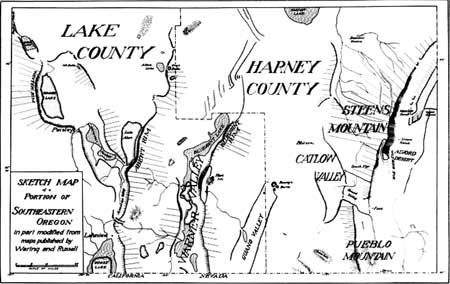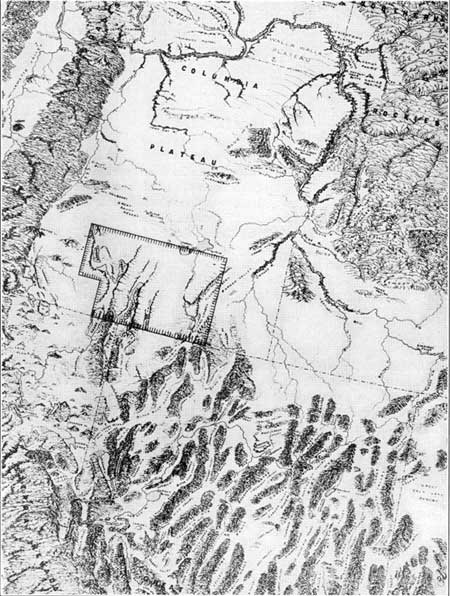
|
University of Washington Publications in Geology
The Geomorphology and Volcanic Sequence of Steens Mountain in Southeastern Oregon |
INTRODUCTION
UNIVERSITY OF WASHINGTON PUBLICATIONS IN GEOLOGY
THE GEOMORPHOLOGY AND VOLCANIC SEQUENCE OF STEENS MOUNTAIN IN SOUTHEASTERN OREGON
By RICHARD E. FULLER
LOCATION
Lying in the arid sage-clad region of southern Oregon, Steens Mountain forms by far the largest topographic feature in the northwestern part of the Great Basin (fig. 1). The major central mass of the mountain consists of a great fault block, which rises gently from the west with an even slope about 25 miles in length. The block, which is but slightly dissected by erosion, is truncated on the east by a scarp, which drops abruptly to Alvord Desert, 5,500 feet below. This scarp has been rendered extremely precipitous by valley glaciation. The summit, with an elevation of approximately 10,000 feet, lies in the south central portion of Harney County, a little less than 50 miles north of the Nevada line at a point approximately midway between the California and the Idaho boundaries (fig. 2).

|
| Fig. 2. R. E. Fuller and A. C. Waters, op. cit., fig. 1, p. 209. (click on image for an enlargement in a new window) |
NAME
In early reports the mountain is referred to as Stein Mountain, which according to hearsay in the region is attributed to the German word meaning "stone," in reference to the magnificent exposures of rock on the eastern scarp. Subsequently the word was corrupted to "Steins." For at least the last 20 years, however, popular usage of the present generation has firmly established the derived appellation "Steens Mountain."
FIELD WORK
The writer's field work in the region has been distributed over seven summers varying in duration from two to nine weeks in length. The first two years were devoted to reconnaissance and to the study of the basalt of the region in comparison to the Columbia River lavas. This investigation necessitated the examination and sampling of the basalt exposed on the major fault scarps.
Subsequently the origin of the structure formed a temporary objective. This culminated in 1929 in a joint publication with Aaron C. Waters on the "Nature and Origin of the Horst and Graben Structure of Southern Oregon."1 In addition to a description of the structural features, this paper included brief comments on the volcanic sequence of the region.
1Richard E. Fuller and Aaron C. Waters, "The Nature and Origin of the Horst and Graben Structure of Southern Oregon," Jour. Geol., vol. XXXVII, p. 204-239, 1929.
CULTURE
Steens Mountain and the adjacent district is very sparsely populated, owing to the fact that its principal industry is sheep raising. In the summer the herds find good pasturage on the higher mountains, while in the winter they forage on the scanty vegetation of the lower deserts, which are but seldom mantled with snow. This industry is largely in the hands of Spanish Basques. The region also contains several cattle ranches with hay land irrigated by the larger streams. The towns named on many of the maps commonly consist of a single store, which contains the post office. In addition, there are numerous deserted homesteads, which as a rule were established about 25 years ago.
ACCESSIBILITY
A network of roads and the presence of playas enables one to motor to within a few miles of almost any locality. Some of the main roads have been improved. Many of them, however, consist merely of trails worn through the sage brush. Locally occasional cloud-bursts render them very rough. Owing to the trend of the faults, the chief difficulty in traveling lies in going east and west.
To the north, a branch line of the Union Pacific ends at Burns, about 20 miles north of Harney Lake. To the southwest, Lakeview, situated at the northern end of Goose Lake, is the terminus of another branch line. The third outlet of the region is Winnemucca, which lies about 120 miles below the Nevada border on the nearest railroad line to the south. These three towns are all prosperous centers of one to two thousand inhabitants. They are all on well constructed highways.
GENERAL GEOLOGY AND SCOPE OF
INVESTIGATION
In southern Oregon, east of the Cascade Range, a varied series of late Tertiary lavas is cut by the northern continuation of the Basin Range faults. The differential movement of the fault blocks has resulted in the formation of seven major depressions which are commonly bounded by precipitous fault scarps varying in height from a few hundred to several thousand feet. These seven depressions, which trend roughly north-south, are in order from west to east: the Klamath graben (containing Klamath Lake), the Summer Lake-Chewaucan Marsh-Goose Lake depression, Warner Valley, Guano Valley, Catlow Valley, Alvord Desert, and McDermitt Valley.
These depressions are all relatively flat-floored owing to the accumulation of sediments in the vast system of lakes which they once formed. The many partially eroded beach terraces on the scarps throughout the region testify to a previous depth of water of about 300 feet above the lake deposits, which in themselves are probably many hundred feet in depth. The surface of the bolson deposit, varying but slightly in the different basins, is over 4,000 feet in elevation.
Since the melting of the Pleistocene glaciers on some of the higher mountains, the lakes have diminished until now their former presence is indicated chiefly by playa flats, which usually have only slight marginal vegetation. In recent years most of the perennial streams in the region have been utilized for irrigation. Denied this replenishment, the few surviving lakes are rapidly being reduced to playas that are flooded only by occasional rains.
The depressions, or grabens, are bounded longitudinally by the steep scarps of the gently tilted fault blocks that border them. Many of these blocks are defined by faults on both sides, and, in consequence, give rise to true horst and graben structure rather than the tilted fault block mountains, which are characteristic of much of the Great Basin. As a rule, the blocks dip away from the major fault.
Only the two highest scarps in the region have been appreciably modified by stream erosion. These two localities are the high eastern face of Steens Mountain and the western side of Hart Mountain, which forms the eastern wall of Warner Valley. Owing to their elevation and the consequent greater rainfall these mountains have many small active streams. The principal erosion, however, probably was confined to the Pleistocene when the climate is thought to have been more humid. To this same period, there is also attributed the marked valley glaciation of the higher portion of Steens Mountain. Fortunately these two localities form the centers of the principal volcanic activity of the region, for the magnificent exposures in the numerous valleys that cut the scarps furnish ideal opportunities for arriving at an interpretation of many of their volcanic phenomena. The higher members of the series, however, have survived erosion only on the lower scarps, which lack the stratigraphic complexity of these two localities. As a consequence their complete interpretation involves merely the study of sections at a few carefully chosen localities.
Although this report is confined principally to the Steens Mountain series, it includes evidence on the stratigraphic relations of these volcanic rocks to those exposed in the adjacent region. Since some of the abundant petrogenetic promlems demand additional study, they have been omitted. The investigation practically ceases at the margin of the desert country which may be roughly outlined by continuing to the southwest the line formed by the western wall of the Summer Lake-Chewaucan Marsh depression until it reaches the western scarp of Warner Valley. West of this line, the exposures are less satisfactory, owing to the rapid increase in vegetation as the Cascade Mountains are approached.
| <<< Previous | <<< Contents >>> | Next >>> |
state/wa/uw-1931-3-1/intro.htm
Last Updated: 28-Mar-2006
